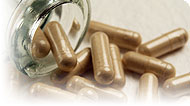Penn Herb Wellness Guide
Vitamin EFind Products

How to Use It
The recommended dietary allowance for vitamin E is low, just 15 mg or approximately 22 International Units (IU) per day. The most commonly recommended amount of supplemental vitamin E for adults is 400 to 800 IU per day. However, some leading researchers suggest taking only 100 to 200 IU per day, since trials that have explored the long-term effects of different supplemental levels suggest no further benefit beyond that amount. In addition, research reporting positive effects with 400 to 800 IU per day has not investigated the effects of lower intakes.1 For tardive dyskinesia, the best results have been achieved from 1,600 IU per day,2 a large amount that should be supervised by a healthcare practitioner.
Where to Find It
Wheat germ oil, nuts and seeds, whole grains, egg yolks, and leafy green vegetables all contain vitamin E. Certain vegetable oils should contain significant amounts of vitamin E. However, many of the vegetable oils sold in supermarkets have had the vitamin E removed in processing. The high amounts found in supplements, often 100 to 800 IU per day, are not obtainable from eating food.
Possible Deficiencies
Severe vitamin E deficiencies are rare. People with a genetic defect in a vitamin E transfer protein have severe vitamin E deficiency, characterized by low blood and tissue levels of vitamin E and progressive nerve abnormalities.3, 4
Low vitamin E status has been associated with an increased risk of rheumatoid arthritis5 and major depression.6 Women with preeclampsia have been found to have lower blood levels of vitamin E than women without the condition.7
Very old people with type 2 diabetes have shown a significant age-related decline in blood levels of vitamin E, irrespective of their dietary intake.8
Best Form to Take
Vitamin E occurs naturally as eight separate compounds (four tocopherols and four tocotrienols) with antioxidant activity. Most clinical research has focused on one of these compounds—alpha-tocopherol. The naturally occurring form of alpha-tocopherol is called D-alpha-tocopherol (or RRR-alpha tocopherol), and the synthetic form is called DL-alpha-tocopherol (or all-rac-alpha tocopherol). Although many studies have shown benefits from the synthetic form, the synthetic form contains isomers not normally found in the human body. Therefore, the naturally-occurring form—D-alpha-tocopherol—might be the preferred form.9
In addition, there is some evidence that supplements containing a mixture of all four vitamin E tocopherols (alpha, beta, gamma, and delta) may be safer and more effective than D-alpha-tocopherol by itself. One researcher has recommended that these mixed tocopherol supplements contain 50 to 100 mg of gamma-tocopherol per 400 IU of D-alpha-tocopherol. Also, water-miscible preparations of vitamin E may be better absorbed than fat-soluble preparations.10
Copyright 2025 TraceGains, Inc. All rights reserved.
Learn more about TraceGains, the company.
The information presented by TraceGains is for informational purposes only. It is based on scientific studies (human, animal, or in vitro), clinical experience, or traditional usage as cited in each article. The results reported may not necessarily occur in all individuals. Self-treatment is not recommended for life-threatening conditions that require medical treatment under a doctor's care. For many of the conditions discussed, treatment with prescription or over the counter medication is also available. Consult your doctor, practitioner, and/or pharmacist for any health problem and before using any supplements or before making any changes in prescribed medications. Information expires December 2025.


